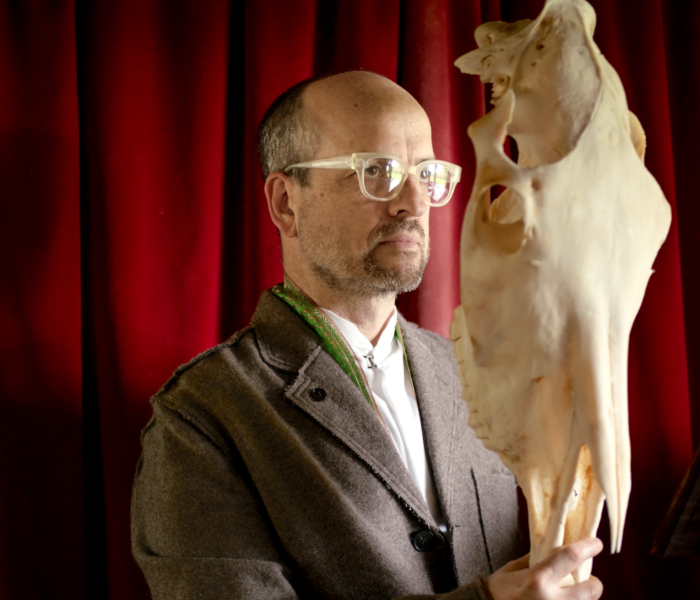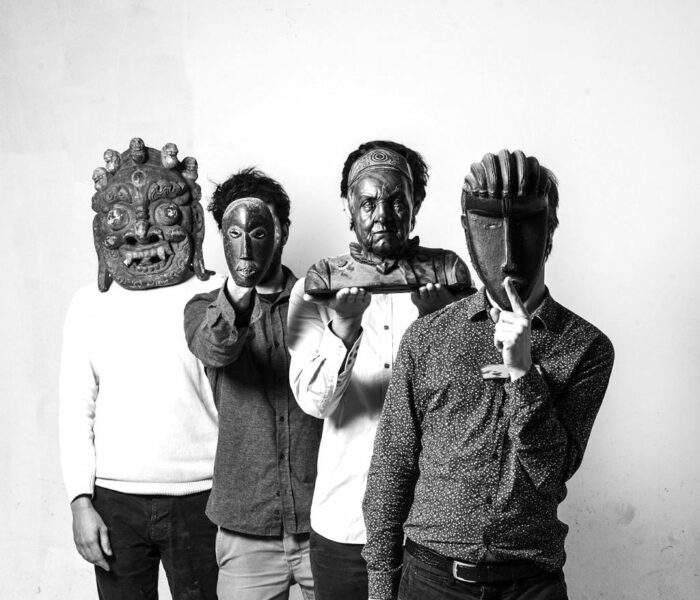Robert Curgenven, Sarah Davachi, Lawrence English, FUJI|||||||||||TA, Kali Malone ou Claire M. Singer : petits frères et petites sœurs d’Eliane Radigue et La Monte Young, ces musiciens ont en commun de remettre l’orgue au goût du jour. Organistes organiques, ils officient au service d’une musique de la stase qui synthétise minimalisme, drone, ambient et musique sacrée.
C’est chose toujours assez vaine que les bilans et les classements de fin d’année. Surtout en ces temps bouleversés par la crise sanitaire, par cette pandémie qui découpe les années – bien plus violemment que la sempiternelle vacance estivale – en une suite de segments où les notions d’hier et de demain, d’avant et d’après deviennent à ce point fluctuantes qu’elles finissent par perdre toute consistance.
On peut néanmoins observer que dans le domaine de ce que l’on appellera les musiques électroniques expérimentales – ces musiques où les œuvres ne sont pas écrites, mais enregistrées -, et plus précisément dans ce genre en soi qu’est devenu la drone music, deux des plus beaux disques parus ces derniers mois (en 2021, donc) ont mis à l’honneur un instrument habituellement rattaché au champ de la musique sacrée et de la musique écrite. Cet instrument est l’orgue (à tuyaux) ; et les disques en question – Antiphonals de la Canadienne Sarah Davachi (née en 1987) et Observation of Breath de l’Australien Lawrence English (né en 1976) – sont les deux dernières occurrences en date d’une tendance plus « lourde » qui remonterait à 2016-17. Plus lourde, et plus mondiale, puisqu’elle rassemble, outre une autre Canadienne – Kara-Lis Coverdale (né en 1987, et titulaire de l’orgue de l’Église estonienne évangélique luthérienne St-Jean à Montréal) – et un autre Australien – Robert Curgenven (né en 1974, et installé en Irlande) -, l’Américaine Kali Malone (née en 1994, installée en Suède), le Japonais Fujita Yosuke, alias FUJI||||||||||TA ou l’Ecossaise Claire M. Singer. Une famille – et on en oublie certainement – éclatée mais dont le port d’attache pourrait se trouver en Suisse, et plus précisément à Lucerne, où siège la très active structure indépendante Hallow Ground, qui a publié plusieurs de ces musiciens…
Instrument-monde
Que peut-on lire dans ce retour à l’orgue ? Faut-il d’ailleurs y lire quelque chose ? Que nous dit cette redécouverte de l’orgue par de jeunes artistes dont la plupart a certes reçu une formation poussée en électroacoustique, mais dont la plupart aussi aborde cet instrument en « autodidacte », comme elle le ferait d’un vulgaire synthé ? Elle nous dit d’abord que l’héritage de La Monte Young n’a pas fini de se diffuser, qui inventa en 1958, avec son Trio For Strings, le minimalisme statique – le véritable minimalisme, si l’on en croit ce qu’écrivent Michel Chion et Juliette Garrigues dans l’Encyclopedia Universalis, fondé « sur des phénomènes continus à évolution lente ou bien sur des micro-phénomènes créés souvent par des moyens électroniques ».
Un héritage filtré – c’est le cas de le dire – par trois des disciples les plus émérites de Young – glorieux aînés toujours vaillants, thuriféraires des vertus de ce « son continu » (drone) qui en français se traduit par bourdon (et qui est aussi le nom d’un registre d’orgue également appelé « soubasse ») :
* Eliane Radigue (née en 1932) d’abord, la première à avoir exploré le son continu, et ses multiples impacts pyschoacoustiques, au synthétiseur, en l’occurrence le ARP 2500 : Sarah Davachi – qui a signé quelques pièces pour orgue seul, mais qui préfère mêler la sonorité de l’instrument à une multitudes d’autres textures instrumentales, acoustiques ou synthétiques (dont le ARP 2500) – en parlait l’an dernier sur le site thequietus.com, à l’égal du Alvin Curran de Songs & Views from the Magnetic Garden, comme de l’une de ses sources d’inspiration privilégiées.
* Phill Niblock (né en 1933) ensuite, qui a expérimenté les pouvoirs de la microtonalité sur une grande variété d’instruments : sa musique pour orgue – deux pièces bruyantes, magmatiques, hallucinantes – a notamment été enregistrée en 2019 par Hampus Lindwall.
* Charlemagne Palestine enfin. Né en 1947, celui-ci a orienté dès le début des années 1970 sa quête du « Son d’or » vers le piano et vers l’orgue d’église, comme en témoigne Schlingen Bängen, créé en 1978-79.
Ces trois figures sont d’ailleurs spontanément convoquées par le toujours très érudit Lawrence English. A Radigue et Niblock sont en effet dédiées les deux pièces qui forment Lassitude, son premier opus à l’orgue, déjà enregistré sur l’instrument conservé au Old Museum de Brisbane. Quand à Observation of Breath, il est placé, selon ses propres dires, sous le sceau du « minimalisme maximal » cher à Palestine. Claire M. Singer, de son côté, a commandé des œuvres à Éliane Radigue et Phill Niblock pour Organ Reframed, le festival qu’elle programme à la Union Chapel de Londres, où elle exerce comme organiste…
Il est vrai que l’orgue est un synthé vintage, « grandeur nature ». Un instrument monde, qui incorpore tous les sons. Comme chacun sait, tout finit toujours par rentrer dans l’orgue.
Organiques organistes
Si elle se rattache à l’histoire, cette jeune génération n’en a pas moins une manière très décomplexée et intuitive d’aborder l’orgue. Ce qui ne veut pas dire qu’elle n’est pas érudite, ni réfléchie, qu’elle ne se pose pas de question par exemple sur la charge « culturelle » (essentiellement religieuse) qui reste attachée à l’instrument, et sur la manière dont il convient d’en jouer…
Kali Malone, par exemple, explique préférer la sonorité sèche d’une salle de conservatoire à l’acoustique réverbérée des lieux de culte où sont généralement enregistrés les disques d’orgue. Cette recherche de neutralité se prolonge jusque dans le jeu, puisqu’elle dit aussi enregistrer chacune des voix de ses « canons » successivement, de manière monodique, plutôt que de jouer les notes simultanément, en une polyphonie d’accords où la sensibilité – voire la sensiblerie – de l’interprète risquerait de prendre le dessus…
C’est bien peut-être cette apparence d’objectivité, cette retenue qui caractérise ces musiciens dans leur approche d’un instrument qui les attire peut-être parce qu’à la richesse et à la plasticité du son, il allie une incomparable physicalité. Cette notion de physicalité est au cœur du travail d’un Robert Curgenven. Mais elle saute également aux oreilles à l’écoute des disques de Kali Malone ou de FUJI||||||||||TA, à l’écoute de ce souffle à la fois éolien et tellurique que produisent les tuyaux, de tous ces bruits que l’organiste est fatalement condamné à émettre en actionnant les pédales ou les registres. Intégrés à l’enregistrement, tous ces sons « parasites », qui font saillir le contraste entre la puissance démiurgique de l’instrument, l’immarcescible pureté de ce son et la fragilité de l’interprète, qui accentuent également la dimension chambriste, intimiste, de l’ensemble, ne rendent l’écoute que plus palpitante. Ils confèrent une subtilité supplémentaire à ces timbres bourdonnants dont les irisations incessantes sont autant de petites épiphanies, qui nous invitent à revenir en ce lieu dont on ne devrait jamais trop s’éloigner : en nous-mêmes. Et qui ne rendent que plus fascinantes ces combinaisons de notes où les harmoniques deviennent à ce point fluctuantes qu’elles finissent par perdre toute consistance…
David Sanson



)



